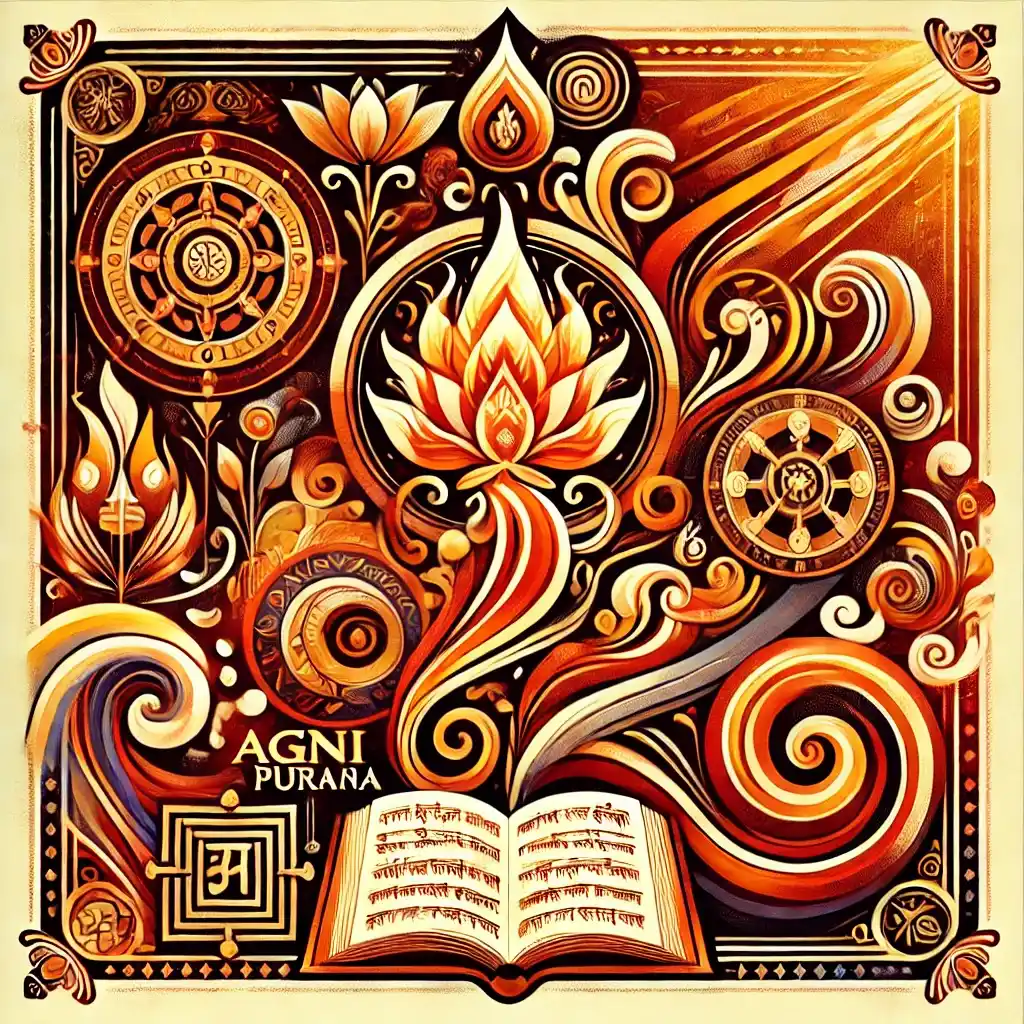
The Puranas
Agni Purana
The Sacred Fire of Knowledge and Devotion
The Agni Purana is one of the eighteen major Puranas in Hinduism, named after the god of fire, Agni. This ancient text, composed in Sanskrit, is a treasure trove of knowledge covering a vast array of topics, ranging from cosmology and mythology to rituals, temple construction, and moral conduct. The Agni Purana is unique in its breadth and scope, making it an invaluable resource for understanding Hindu religion, culture, and traditions.
Historical Background and Composition
The exact date of composition of the Agni Purana is not definitively known, but scholars generally place its origin between the 8th and 11th centuries CE. It is believed to have been composed over a long period, with contributions from various authors. The text is named after Agni, the fire god, who is revered as a purifier and a mediator between humans and the divine. Agni is also considered the mouth of the gods, through whom offerings are made to the deities in Hindu rituals.
The Agni Purana is classified as a Tamaasic Purana according to the Padma Purana, meaning it is associated with the mode of ignorance, which in this context refers to its emphasis on rituals, magic, and mantras. However, this does not diminish its significance; rather, it highlights the Purana’s focus on practical aspects of worship and religious practices.
Structure and Content
The Agni Purana is divided into 383 chapters, containing over 15,000 verses. The content of the text is vast and varied, covering the following major topics:
Cosmology and Mythology: The Purana begins with a detailed account of the creation of the universe, the genealogy of gods and sages, and the various epochs (Yugas) of Hindu cosmology. It narrates the stories of the major deities, including Vishnu, Shiva, and the goddess Durga, along with the legends of various incarnations (Avatars) of Vishnu.
Rituals and Worship: A significant portion of the Agni Purana is dedicated to describing rituals, sacrifices (Yajnas), and religious ceremonies. It provides detailed instructions on the performance of various rites, including those related to birth, marriage, and death. The text also emphasizes the importance of devotion (Bhakti) and the recitation of mantras for spiritual advancement.
Temple Construction and Iconography: The Purana offers comprehensive guidelines on the construction of temples, the installation of idols, and the correct proportions and attributes of deities in Hindu iconography. These instructions have historically influenced temple architecture and sculpture in India.
Moral and Ethical Teachings: The Agni Purana contains numerous teachings on Dharma (moral conduct), emphasizing the importance of righteousness, truthfulness, and compassion. It also discusses the duties of different castes (Varna) and stages of life (Ashramas), as well as the principles of governance and statecraft.
Warfare and Medicine: The text provides detailed descriptions of various weapons and military strategies, reflecting the martial traditions of ancient India. Additionally, it includes sections on Ayurveda (traditional Indian medicine), covering topics such as herbal remedies, treatments for diseases, and the importance of a balanced diet.
Astrology and Divination: The Agni Purana also delves into the field of astrology, offering insights into the interpretation of planetary positions and their influence on human life. It includes methods for predicting auspicious times for various activities and rituals.
Philosophy and Spirituality: While the Agni Purana is primarily focused on rituals and practical aspects of religion, it also touches upon philosophical concepts such as the nature of the soul (Atman), the cycle of birth and rebirth (Samsara), and the attainment of liberation (Moksha).
Significance and Influence
The Agni Purana has had a profound impact on Hindu religious practices and cultural traditions. Its detailed instructions on rituals and temple construction have been instrumental in shaping Hindu worship and temple architecture across India. The text’s emphasis on moral conduct and devotion continues to resonate with followers of Hinduism, inspiring them to lead righteous and spiritually fulfilling lives.
Moreover, the Agni Purana has contributed to the preservation and propagation of Hindu mythology, ensuring that the stories of the gods, sages, and heroes are passed down through generations. Its teachings on Ayurveda and astrology have also had a lasting influence on these fields, which continue to be practiced in India today.
Conclusion
The Agni Purana is a remarkable work that embodies the rich and diverse traditions of Hinduism. Through its comprehensive coverage of topics ranging from cosmology and mythology to rituals and ethics, it serves as both a guide for religious practice and a repository of ancient knowledge. For scholars, devotees, and anyone interested in Hinduism, the Agni Purana remains a vital text that offers insights into the spiritual and cultural heritage of India.

Explore the latest and most popular products available on Amazon, handpicked for your convenience! Whether you're shopping for tech gadgets, home essentials, fashion items, or something special, simply click the button below to view the product on Amazon. We’ve partnered with Amazon through their affiliate program, which means that if you make a purchase through this link, we may earn a small commission at no extra cost to you. This helps support our site and allows us to continue providing valuable content. Thank you for your support, and happy shopping!